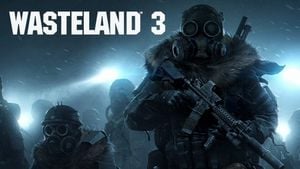Wasteland 3: Statistics - character development Wasteland 3 guide, walkthrough
Last update: 08 September 2020
On this page of the Wasteland 3 guide, you will find information on the statistics that define your character.
Each party member is defined by a series of statistics. They determine the combat abilities of the characters and their resistance to statuses. They are dynamic and change depending on the attributes and abilities developed, as well as the armor worn.

A character is defined by the following statistics:
- Condition (CON) - determines the character's health points. When this bar drops to zero, the character loses consciousness and is excluded from the fight. However, if you fail to revive the hero by the end of the turn, that character will die;
- CON per level - it determines how many extra condition points you will get when you level up;
- Healing bonus - determines by how many % healing items work better on a character;
- Action Points (AP) - combat in the game is turn-based. Each action performed during a turn costs you a certain number of action points. The more you have, the greater the range of movements available. Unused AP can be transferred to the next round;
- Action points (max.) - determines how much maximum AP a given character can have. This limit also includes points that were retained from previous turns;
- Hit chance - determines the base probability that the hero will hit the target;
- Critical hit chance - determines the percentage probability that a shot will inflict critical damage;
- Critical damage - determines the damage multiplier inflicted during a critical hit. The bigger it is, the more severe the damage;
- Penetration - describes how much armor your attack can penetrate;
- Sneak attack damage - describes the bonus to damage inflicted on opponents who are unaware of your presence;
- Attack rate - describes the speed at which the special ability rate increases;
- Armor - determines resistance to attacks. The higher its value, the less likely you are to receive 100% of the damage when attacked with a classic weapon;
- Dodge - shows the chance for a character to perform a dodge;
- Resistance to critical hit, fire, cold, energy, explosions, and radiation - all these parameters determine how a character deals with the given effects;
- Downed time - defines how long a character can be unconscious before he or she dies;
- Damage bonuses - specify bonuses for particular types of damage;
- Perception - the higher the value, the more likely the character is to spot traps and alarms;
- Throwing range - describes how far a character can throw objects, such as grenades;
- Initiative - defines the chance of starting the first turn upon getting detected by enemies;
- Detection time - determines how long you can stay within an opponent's before starting a fight;
- Combat speed - this indicator tells how many fields a character can move using a single AP;
- Quick slots - specifies the number of items you can have assigned to the quick slots bar;
- Leadership range - describes the area within which the leadership skill works;
- Experience bonus - determines how quickly a character receives XP and advances to higher levels;
